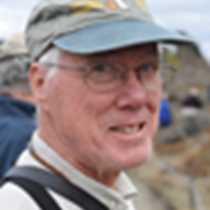Hornsund, West Spitsbergen, Svalbard
With last night’s Expedition Report completed and submitted so promptly by my esteemed colleague, I get to report on our evening. It was but a short run to our next destination of Hornsund, so we headed out into the open Barents Sea towards the shelf break, where deeper oceanic water meets the shallower water over the continental shelf, to search for marine mammals of the large and blubbery sort. Very large. With the sharp eyes and keen attention of Richard White in the crow’s nest, if they were there, we would find them. Find them we did – both fin and blue whales – the two largest animals to occupy our watery planet, larger even than the largest of the dinosaurs. These giant baleen whales are still much reduced in abundance by past exploitation, but we seem to find them more frequently on our trips to various destinations. Are they becoming more abundant with protection from commercial whaling, or are we simply getting better at finding them? We can only hope that it is some of each.
In the early morning we turned into Hornsund, a fjord system that cuts into the coast of southwest Spitsbergen. At the morning wake-up call we were in front of Samarinbreen glacier. We had hoped to kayak here, but the sight of a large polar bear on the floating ice in front of the glacier dissuaded us. We watched the bear and ceded the territory. In nearby Brepollen Bay, where Stor(= “big”)pollen glacier reaches the sea in a glacial face several miles wide. We found no polar bears, so we launched our fleet of inflatable watercraft: kayaks and Zodiacs. Those who explored by kayak paddled languidly and gracefully among the chunks of ice calved from the nearby glacier. The soft light of a high overcast sky enhanced the blue color of the glacial ice. The Zodiacs cruised toward the glacier face searching for wildlife and ice photo opportunities. Some found a “friendly” ivory gull, the all-white phantom of the northern ice (it’s genus name, Pagophila, means “ice loving”) that allowed our close approach. Others encountered a bearded seal lounging on an ice raft as cameras clicked.
Hornsund is at the end of a natural corridor over the ice that connects the east and west sides of the Spitsbergen, an easy stroll across the island for a polar bear. This made it a very productive site for hunter/trappers. In the afternoon we visited Gnålloden, where a simple hut reminds us of the lonely life of a Norwegian trapper. Nearby we saw the outline of an earlier hut used by 17th and 18th century Pomar (Russian) trappers. At least one of them never made it home; his grave lies on a small peninsula near the hut. Kittiwakes and guillemots nest in enormous numbers on the imposing white cliff of Gnålloden. With each trip back from the sea, coming and going to feed their young, they bring the nutrients that enhance the growth and flowering of tiny tundra plants. One scarcely sees the tiny blossoms while walking; they are to be appreciated in the hands-and-knees posture of an Arctic plant-lover.
Call +1.800.397.3348 or contact your travel advisor




